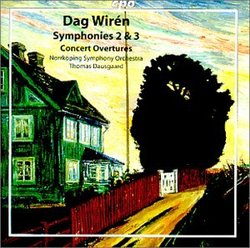| All Artists: Dag Wiren, Thomas Dausgaard, Norrköping Symphony Orchestra Title: Dag Wirén: Symphonies & Overtures Members Wishing: 0 Total Copies: 0 Label: Cpo Records Original Release Date: 1/1/2000 Re-Release Date: 4/11/2000 Genre: Classical Style: Symphonies Number of Discs: 1 SwapaCD Credits: 1 UPC: 761203967728 |
Search - Dag Wiren, Thomas Dausgaard, Norrköping Symphony Orchestra :: Dag Wirén: Symphonies & Overtures
 | Dag Wiren, Thomas Dausgaard, Norrköping Symphony Orchestra Dag Wirén: Symphonies & Overtures Genre: Classical
|
Larger Image |
CD Details |
CD ReviewsAttractive absolute music from Sweden Evan Wilson | Cambridge, MA | 02/04/2002 (5 out of 5 stars) "Dag Wiren is one of those composers who is known, if known at all, for one piece--the Serenade for Strings, Op. 11 which shows up periodically on discs of Scandanavian favorites. To give us a further idea of this Swedish composer's work, CPO has issued 4 of his 5 symphonies (the 1st was suppressed) on two discs. I intend to review both discs here, so this review will be copied under the other disc.Wiren believed in absolute music, so none of these pieces indulges in the pictorialism of Strauss or the impressionism of Debussy. In addition, Wiren's muse was given to terseness, so the longest piece on either disc is a 30 minute symphony with the remainder of the pieces being around 20 minutes.These two disc also illustrate two very different sides of Wiren's temperment. Basically, it seems to me, Wiren got more severe and terse as he got older. Thus, the disc containing the 2nd and 3rd symphonies and two overtures contains far more approachable music than the disc with the 4th and 5th symphonies and the ballet suite. That said, there is nothing on either of these discs that will send the moderately adventurous listener running from the room.What does Wiren sound like? Well, like a lot of Scandanavian composers, he doesn't always escape the influence of Sibelius, particularly in his use of slow harmonic motion and cold, clear orchestral sounds. Both the 2nd and 3rd symphonies contain memorable thematic material which reminds me vaguely of Sibelius' early symphonies. This disc is clearly the place to start with Wiren, because it contains ideas that will stick easily in your memory. Both overtures are tuneful delights as well.The disc containing the 4th and 5th symphonies is more difficult. Both pieces have an austerity that reminds me of Vaughan Williams late music. The 4th has an otherworldly quality akin to the bizarre finale to VW's Sixth Symphony. The Fifth seems to inhabit the world of VW's 7th and 9th symphonies, although I must stress that Wiren does not indulge in modality the way Vaughan Williams does. Instead, there is a sense that everything has been pared to the remote, abstract core. The 4th, for instance, is a 18-minute piece in three movements built completely around the opening theme heard on the clarinet. It isn't always easy to follow the meaning in either of these pieces, but it is fascinating and entrancing in its way.The ballet suite on the disc with 4 & 5 is much more tuneful and reminiscent of the earlier symphonies. Even here, though, I detect a slight distancing, as if Wiren was hearing the dance tunes of an earlier era through a veil. Both discs are reasonably well played. One might hope for a little more tonal beauty in the later pieces than one gets here, but it's likely no one else will ever record these pieces. As with all CPO records, we get good notes that tell you what to look for. The sound is well balanced, if not exceptionally warm.If Wiren intrigues you, take a chance on the 2nd and 3rd symphonies first. If you like late Vaughan Williams, the 4th and 5th might also catch your fancy."
|

 Track Listings (8) - Disc #1
Track Listings (8) - Disc #1